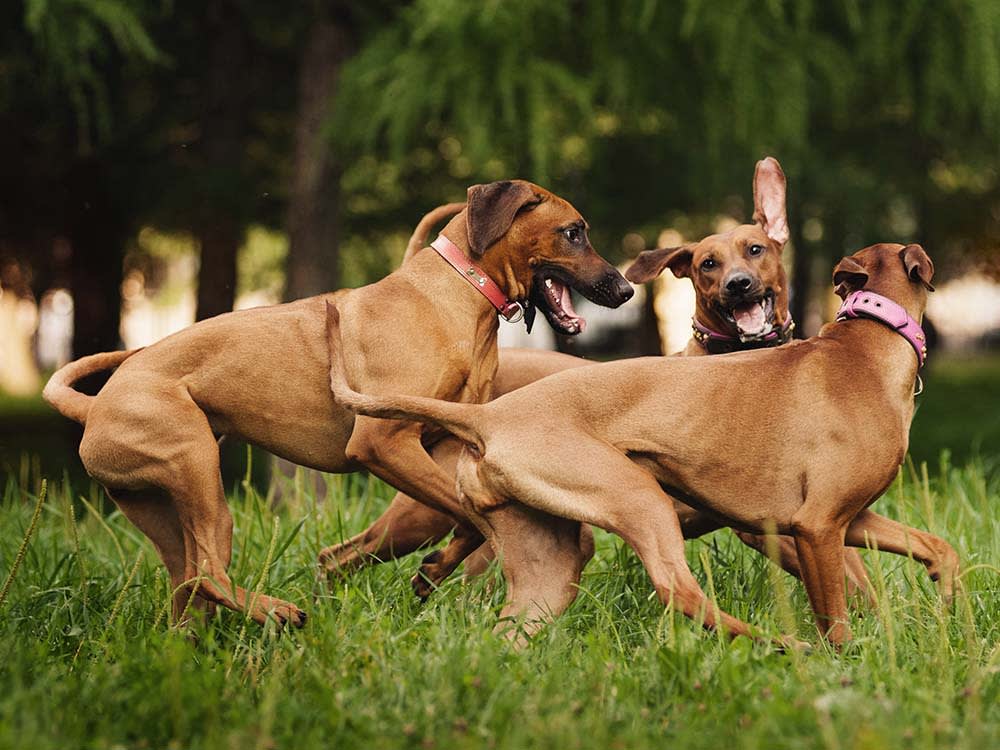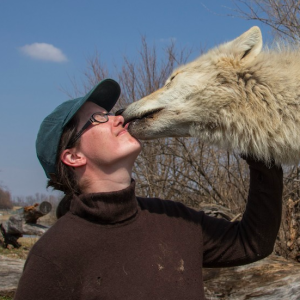Understanding Canine Social Hierarchies
In case you’ve ever wondered what it’s like to live in a dog society.
The canine relationships in my house are friendly but complex: My young Collie mix, Jenny, regularly commandeers food and toys from my elderly Golden, Jack, taking them directly out of his mouth. He tolerates this with characteristic patience. This one-way flow of resources from Jack to Jenny might imply that she holds the higher rank in their mini-hierarchy.
Yet, when she greets him after an absence, she does so with classic submissive body language, licking him under the chin. And when he really cares about a particular toy, such as his beloved red ball, he protects it with a quiet growl that she immediately respects. How am I to interpret their social ranking — who is dominant and who is subordinate?
Of course pet parents try to interpret the dynamics of their dogs. But pup relationships — and ‘rank’ as it’s referred to in the academic world — matter beyond our observational fascination: Some approaches to training and managing canine aggression are constructed around theories about rank relationships between dogs and humans. But because science hasn’t traditionally considered this particular aspect to be an interesting research area, the depth of our actual understanding of canine social hierarchies leaves much to be desired. However, “dog science” has begun to grow in recent years, becoming a newly respectable field producing more and more data, so that may be starting to change.
What We Don’t Know About Dog Hierarchy
The question of how dogs understand and assert rank has been fodder for ferocious contention among dog trainers. The “dominance” theory of dog behavior holds that much of canine aggression is due to an attempt to assert a high rank (in other words, dominance) over a lower-ranking group member. Therefore, aggressive behavior may be reduced by a human display of behaviors associated with high rank in dogs (or their close relatives, wolves).
For example, an owner might seek to reinforce her dominant status by ensuring that she passes through doors before her dog, eats before her dog, and never loses a game of tug. This traditional approach is still practiced by many, yet is heatedly debated. Karen London, PhD, CAAB, CPDT, has referred to dominance as “the D-word,” playfully suggesting that it is too offensive a concept to write about.
Dominance theory is not based on a scientific understanding of how to change animal behavior. Dr. Patricia McConnell, PhD, CAAB, called dominance “one of the most misused and misunderstood words in the English language, at least in relation to dog training.” Its practice can actually lead to increased aggression in dogs, potentially resulting in humans being bitten and dogs being surrendered to shelters, or even euthanized.
Science has not supported us in our quest to understand the relationship between canine rank and aggression. Social hierarchies have been studied extensively in wolves, both captive and wild, and in non-human primates — but rarely in dogs. Traditionally, researchers seem to have perceived Canis familiaris (aka domestic dogs) as tainted by human intervention — not a natural species and therefore not worthy of study. Domesticated species have traditionally been uninteresting to behavioral ecologists (scientists who study behavior and evolution).
Lack of data about how dogs understand and express rank and the charged environment around the use of rank in explaining dog behavior discourage a nuanced discussion of how often dogs have dominant-subordinate relationships with each other, and how dog social hierarchies are structured. These are important questions as research on canine behavior, once so sparse, begins to flourish.
What We Have Learned
The best way to answer questions about how dogs interact is (surprise!) to watch a lot of dog interactions. Behavioral ecologists at Utrecht University in the Netherlands did exactly that, recording the behavior of a group of 10 dogs over the course of two months. It was a young group with only one adult, a two-year-old female Cairn Terrier. The rest were puppies and adolescents under 18 months. In fact, the three highest-ranking dogs were all juveniles: a six-month-old male Beagle, a one-year-old female Malinois and a five-month-old male Doberman.
Every morning, the dogs were let out of their individual kennels into an outdoor enclosure. Here, among thousands of group interactions, individual one-on-one exchanges were selected for analysis. Researchers sought answers to specific questions: How strict is the division between animals of different ranks? What does the rank hierarchy of this group look like: a straight line or a looping one? And perhaps most critically, do dogs show aggression to group members of lower rank?
As it turned out, this group was not particularly egalitarian. Division between ranks was nearly always strict, requiring a dog to greet his superior, even one just a single rank above him, with deferential behavior such as lowered body posture. However, two pairs of middle-ranking dogs were exceptions to this rule. These pairs of dogs were comfortable interacting with each other without formal rank-signifying behavior. This laxness may suggest that precise rank is less important in the middle of the hierarchy than at the top or in the depths. Alternately, it may signify that these dogs were jockeying for position, attempting to climb just one step higher up the ladder by deferring to their superiors as rarely as they could get away with.
Indeed, the social hierarchy in this group did resemble a ladder: Some species have a dizzying hierarchical structure, in which rank order may loop in an entirely nonlinear fashion. In this dog group, however, the hierarchy was strictly linear: if dog A was higher ranking than dog B, and dog B was higher ranking than dog C, then dog A would always be higher ranking than dog C. No weird circular messes — occasions, for example, when dog C was surprisingly dominant over dog A — were observed.
The question of what behaviors higher-ranking dogs offer their subordinates is key. Did higher-ranking dogs routinely show aggression, as dogs labeled “dominance aggressive” would be expected to do? The researchers observed that higher-ranking dogs greeted their subordinates with high tails and pricked ears, and subordinate dogs responded by lowering their body posture, sometimes breaking into a full-body tail wag. Though some growls and lip-lifts were observed, these behaviors appeared on both sides of the divide, offered from high-ranking dogs to their subordinates, and from subordinates to those higher up the ladder. In this group of dogs, aggressive behavior had absolutely nothing to do with rank. This important piece of data further argues against the use of dominance theory in working with aggressive dogs.
What We Will Learn
I read this study not to learn about the interactions of a group of Dutch dogs who live thousands of miles from my home, but to glean insight into the ways my own dogs interact. The bad news is that this study isn’t going to give us the final answer on how dog social hierarchies operate. The good news is that it gives us a solid new tool to use to learn more.
This particular study group was very young, consisting entirely of dogs two years of age or less. Companion dogs come in a somewhat wider variety of ages, and this may well affect how they interact with each other. While the characteristic full-body tail wag of a puppy was a common behavior in this group, the preferred low-status markers may have been different if a group of adult dogs had been observed instead. The whole structure of the hierarchy could have differed as well.
Companion dogs also come with, let’s say, a bit of breed variety, including the ever-unpredictable mixed-breed dog. The study group comprised only medium- and large-sized dogs, of which about half were Beagles. A group of fun-loving Labradors might not have had such strict rank hierarchy; a group of rule-obsessed German Shepherds might have had an even stricter one. And very small dogs might have interacted in completely different ways.
The dogs who live in our homes often (but not always!) congregate in smaller groups than the study’s 10-dog crew. And because they live in our homes, not in kennels, they usually interact with one another much more often than a single hour daily. Compared to their interactions as extended family groups in the wild, wolves show more formal hierarchies when they live in captive environments in which they cannot choose their pack members. We don’t know how the kennel environment changes canine social interactions.
The dominance theory of dog training depends heavily on the hypothesis that dogs consider humans to be part of their social hierarchy. This hypothesis remains to be investigated. In some species, males and females occupy two completely separate hierarchies. Similarly, dogs may see humans as living in their own separate rank order, or they may see us as part of their societies. We won’t know until we research further.
The Utrecht study offers us some insight: The protocol it defines can and should be used again: on dogs in larger groups and smaller groups, older dogs, dogs of different breeds, groups of just males or just females. We should refine the protocol to find its weaknesses and expand on its strengths. We should design new protocols that let us ask if canine and human rank hierarchies overlap. We should start asking what it’s like to live in dog society. We should ask not just to further discredit dominance theory, but also to build a deeper understanding of the animals whose lives are coupled so closely with our own. There is so much more to know about the dogs we live with, and we are just beginning to learn.

